The Masters of Chaos / Les Maîtres du Desordre
Review by Victoria Hobday
The Masters of Chaos / Les Maîtres du Desordre at Quai Branly, Paris, 11 April — 29 July 2020
Europe is engulfed in financial chaos and existential crisis, so this is the perfect time for an exhibition about controlling chaos by appealing to the gods — all of them. Quai Branly opened in 2006 and is the central ethnographic museum in Paris. Apart from an extensive permanent collection it has a temporary exhibition program that is worth exploring when in Paris. The major Spring exhibition this year is Les Maîtres du Desordre (The Masters of Chaos), curated by Jean Loisy, the new director of the revamped Palais de Tokyo. Loisy worked closely with co-curator Sandra Adam-Couralet and anthropologist and curator Bertrand Hell to produce this dense and well-structured exhibition. Loisy is well known in the contemporary art world but is not usually associated with ethnographic or anthropological exhibitions: contemporary art meets ethnography.
The exhibition that results from this collaboration focuses on shamanism. A shaman is a person or object that facilitates access to powers or spirits beyond the temporal world, often through ritualistic practices. The themes of the different parts of the exhibition describe chaos and disorder and humanity’s attempts to control, pacify and understand it. The wide variety of works on display comes not only from the Quai Branly’s collection but also from museums and private collections across the world.
The exhibition environment is designed by architects Jakob + Macfarlane as an amorphous maze of rough hewn irregular white plasterboard walls, with the objects displayed on an exposed metal structure, resulting is a space sympathetic to the different themes of the show (Figs. 1, 2). Although the metal structure guides you through the exhibition, there are a number of cul-de-sacs and circular spaces that serve to disorientate the visitor and immerse them in the exhibition. According to the wall text this environment is ‘designed to go along with the evolution of the visitor’s psychic sensations as they journey through the exhibition.’ Its form is quite dominant and at times appears self-consciously raw, but it would be hard to imagine this exhibition being as effective in a more conventional exhibition space.
The contemporary works are chosen to show the continuity into the present of many of the concerns embodied in the ethnographic pieces. These are by well-known artists such as Jean-Michel Basquiat, Annette Messager, Pablo Picasso, Joseph Beuys and Paul McCarthy. They respond well to the challenge of being placed in such a thematically driven show, although at times the connections can seem forced.
There are three main sections: the first is about ‘chaos in the world’, the second concerns the ‘control of chaos’ and the last addresses ‘catharsis’. Within these larger sections are smaller sub-themes that focus on such ideas as ‘imperfect order’, ‘the powers of chaos’, ‘intercessors’, ‘clowns’, ‘initiation’, ‘cosmic travellers’, ‘flight’, ‘metamorphosis’, ‘sickness’, ‘exorcism’, ‘music’, ‘bacchanalia’, ‘the festival of fools’, ‘the winter festival’, and ‘the profane’. The relationship between the main themes and the sub-themes is carefully considered and it is clear which idea each work is intended to inform.
Directly in front of you as you enter the maze is a large installation by Thomas Hirschorn called Outgrowth (2005) (Fig. 3), which looks like an enormous schoolboy’s geography project. Globes are partially wrapped in parcel tape creating large bulges that protrude irregularly like enormous tumours. Taped to the shelves that support the work are photographs clipped from the news media showing global disruption and disaster. Many of the photographs are instantly recognisable, such as those of the collapsed World Trade Centre towers or the bombing of Baghdad; others are more obscure but equally disturbing. Hirschorn uses photographs in the way that newspapers use text: the photograph describes the impetus for the tumour erupting from the globe that sits on the shelf above. These shapes do not correspond in any measurable way to particular events; rather they signal imbalances in the world and in the individual that are the consequence of such events.
Opposite this work are three seventeenth-century wooden panels believed to be from a cart from Sarangapani in India that would have been used in processions (Fig. 4). They depict a story about the struggle between the gods that work for order in the world and the demons of chaos and disorder, whose disorder is perhaps echoed by the irregular display window in which the three pieces are placed. Although initially these works are not particularly visually striking their inclusion as works from India seems to be consciously chosen to alert the visitor to the mixed ethnographic nature of this exhibition. In the same space there is an early twentieth–century mask from the Ivory coast made of wood, straw, claws, horn, dried blood, shells, nuts resin and iron nails (Fig. 5). Next to this are three abstracted wooden Aripa figures dating between the sixteenth and the nineteenth centuries from the Inyai-ewa people of the Sepik river in New Guinea (Fig. 6). They are long and narrow, as though seen in profile, and each is intended to protect and guide a particular individual.
Many of the objects throughout the exhibition are figurative or reflect the animal world in masks made for ritual dance. These figures are created to control or personify the chaos of unpredictable weather or events of nature, to protect against the ravages of illness or to attract good fortune. They are created as vessels that focus the desires of the individual or society; sometimes this is through the personification of animal traits in masks, costume or figurines (Fig. 7). The remarkable thing about these objects is the similar way that different societies call upon assistance from higher powers. Often the use of bones, horns and feathers create an alien presence, the combination of traits and mediums serve to remove the figures from the earthly world and are often quite disturbing to look at (Fig. 8).
The incorporation of both documentary and video art is well thought out and serves to effectively animate the exhibition. In the centre of the exhibition is a circular space around the edge of which is a circular bench with old-fashioned telephone receivers with numbers on them hanging down, opposite a number of small screens in the centre that seem to be running without sound. Visitors sit around the edge of the space listening to the documentaries through the numbered phones and can watch the documentaries on the corresponding screens. Each screen shows different intercessional shamanistic practices from cultures around the world, including from regions such as Tadjikistan, the Amazon, the Navajo lands, the Maghreb, Benin and Togo, Haiti and Mexico. There is a whiff of old-fashioned colonial anthropology in all this, and it fails to address the possibility that established modern religions, like Chrstianity or Islam, might engage in comparable practices. However, in other sections of the exhibition the shamanistic nature of Christian artifacts is addressed. A painting of St Michael and a Demon by the Avignon painter Josse Lieferinxe (died 1505/8) (Fig. 9) shows the saint as a celestial protector with all the attributes necessary to overcome the demon of disorder: he holds scales and a crucifix-topped lance while raising his sword to strike Satan. Other demon figures are shown in both ethnographic works and contemporary works such as Jean-Michel Basquiat’s painting Exu (Fig. 10). The way the exhibition generates connections between works of diverse cultures in this way is its great strength, and one’s response to the St Michael in this context is quite different from when it is seen in the church from which it came, or in an art-historical exhibition.
On the contemporary side, there are many video works from different times including among others Anna Halprin’s Dancing my Cancer (1975). Anna Halprin is a major figure in contemporary dance, and in this black and white video she dances in front of a canvas she has painted to represent the cancer she was fighting at the time (Fig. 11). This work is shown in the section of the exhibition entitled ‘Catharsis’. From a distance you hear Halprin’s voice screaming guttural sounds. She is shown only from behind, dressed in a dark cassock, and her movements are at once compelling and furious. Other statuettes, ex-votos and amulets also relate to the concept of catharsis, since protecting or curing is at the heart of their purpose. Terracotta figures from Hellenistic Smyrnos show various afflictions, such as rickets, that it is thought the owner wanted to avoid or cure. The humanity of these figures is touching, as they vividly convey the desire and desperation of the original owners. Similarly a nineteenth-century statuette from Gabon shows the deformity of on an old woman afflicted with trypanosomiasis (sleeping sickness), which became prevalent in equatorial Africa in the late nineteenth century, and which was thought to be the result of an imbalance in the spirit world (Fig. 12). Like the Greek terracotta, this statue was supposed to protect or cure its owner, and it was employed in a complex ceremony that consisted of sacrifices, special herbal potions, music and whistling. While the bent legs are typical of most wooden figures from this region, the distorted arms echo the terrible disfigurement of many sufferers of this disease, some of whom would fall asleep over cooking fires.
The presence of items associated with the cult of voodoo from different societies is perhaps the most expected part of the exhibition. These objects are made up of a variety of ingredients that are combined by the shaman to create supposedly powerful and magical outcomes. In the foreground of the display is what amounts to a sorcerer’s bag of goodies: claws, shells, hair of various animals, hooves and strange bones. It is as if the owner has collected flotsam and put it all in a sack to dry (Fig. 13). This informs the other works in the display, which are often sacks containing bones, sticks and other objects hidden from view (Fig. 17). Particularly powerful are the objects that are mystical sources of power known as boliw, used for male initiation ceremonies in Benin and Mali. These are made of materials like mud, stone, claws, wood, blood, fragments of the bodies of ancestors and placenta. The boliw fetish figure called a Bolidenfa is featureless and ill-proportioned, its texture cracked and monochrome, yet it is somehow human in form (Fig. 14). Such figures were created as representations of the spirit of the bush in a perpetual state of ‘becoming’ and were meant to be frightening to look at. They still retain their power to terrify, and justify the warning at the beginning of the exhibition about the nature of some of the displays.
A diversity of costumes is exhibited throughout the exhibition. Costumes can sometimes be difficult in exhibition spaces: without mannequins they look empty and powerless, but placed on mannequins—with or without heads—they can look like they belong in a shop. Fortunately for this exhibition the majority of costumes are associated with complex masks, so the problem does not arise. The point of these costumes is to transform the wearer into something un-human, and it is striking how similar are the ways costume makers from widely separated cultures do this. In a costume of a Sourvaskar from Bulgaria, which was used in winter solstice celebrations designed to tempt the sun to return, the human form is changed by the costume into something large and foreign (Fig. 15). Similarly the Awauta costume from the Kamayura people of the Amazon changes the wearer’s shape, in this case into a mass of moving straw that weighs nearly fifty kilos, and is worn by the shaman during an initiation ceremony that lasts for three nights (Fig. 16). This ceremony involves dancing and communicating with the most dangerous spirits, and once it is over the costume is hung in the men’s house until it decomposes.
Particularly successful is the section dealing with clowning and foolery as a form of sanctioned transgression that alerts societies to the folly of order by providing release from it. Burlesque music comes out of the speakers of an installation by Arnaud Labelle-Rojoux in the form of a cart pulled by rabbits (2011). On the wall behind is a delicate work by Hieronymus Bosch, Le Concert dans l’oeuf, that shows a crowd of medieval fools attempting to interpret a sheet of music sitting in a cracked egg (Fig. 17). An owl sits on the head of one person, a stalk on another. Playing beside it is a Paul McCarthy video, Painter (1995), where the artist fumbles about with paint wearing a large nose, a wig and absurdly large hands, while talking to himself and another character about his creativity and his fame. Opposite is a display of fools from the sixteenth and seventeenth centuries carved in wood and ivory (Fig. 18). This is followed by five of the controversial reworked Goya etchings by Jake and Dino Chapman, controversial not only because of their imagery but because they ‘deface’ works by a famed Old Master (Fig. 19). This section has a large number of contemporary works that reflects the present engagement with transgression and humour in many of these artist’s works.
This exhibition is so dense in objects, concepts and cultures it could have been a whole season of exhibitions. What is particularly admirable is the courage exhibited by the curators in combining serious ethnographic study with a concept-driven collection of contemporary work. The result could have been confused if it were not so well executed. It may well become a model for this kind of exhibition, and curators are probably already mapping out conceptual interconnections for exhibitions of their own along these lines.
© Victoria Hobday 2012
Fig 1. Floorplan of Exhibition
Fig.2. Detail of Exhibition environment.
Fig 3. Thomas Hirschorn Outgrowth (2005)
Fig 4. Wooden panel from processional cart showing Narashima fighting Hiranyakasipu (Sarangapani, India, seventeenth century)
Fig 5. Koma Ba mask, (Population maou, Ivory coast, 1900-1950.) 87 x 34 x 68 cm.
Fig 6. Aripa figures, Population Inyai-ewa, Sepik river, New Guinea (early twentieth century).
Fig 7. Komo Mask (Population malinké, Guinea, late nineteenth–early twentieth century) mixed media,97.5 x 37 x 38.5 cm.
Fig 8. Topu (Popuation tapirapé, Brazil, 1960-1972) mixed media 41 x 6.5 x 20 cm.
Fig 9. Josse Lieferinxe, Saint Michael steps on the devil (Avignon School, late fifteenth–early sixteenth century) oil on wood, 87.5 x 66.2 cm.
Fig 10. (on right) Jean-Michel Basquiat, Exu (1988). 199.3 x 254 cm.
Fig 11. Anna Halprin Dancing my Cancer (1975) black and white video.
Fig 12. Female statue (Population Tsogho, Betsi, Gabon late nineteenth–early twentieth century) wood, 22 x 4 x 5 cm.
Fig 13. Sack of magical objects Mabyala,(Population Hoyo, Angola, before 1932) mixed objects 15 x 15 x 48 cm.
Fig 14. Bolidenfa (Mali, 19th C.) 60 x 10 x 40 cm
Fig 15. Costume de Sourvaskar (Bogdanov dol, Bulgaria, before 1990) mixed media, 151 x 114 x 38 cm.
Fig 16. Mask and costume Awauta (Population kamayura, Amazon, 1911) mixed media.
Fig 17. Jerome Bosch, The concert in the egg (1561) oil on panel, 108 x 126 cm.
Fig 18. Exhibition display of fools from western europe.
Fig 19. Jake and Dino Chapman, Like a dog returns to its vomit (No.63) (2005, guache over the engravings Los Caprichos by Francisco de Goya) 44.8 x 37.2 cm.
[Click on thumbnails to see larger images]

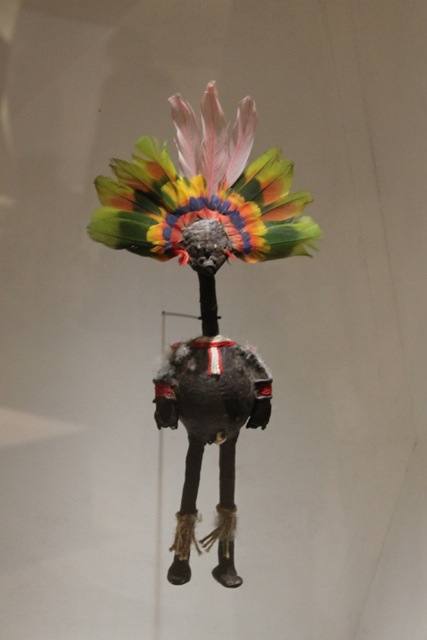
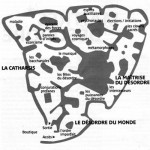
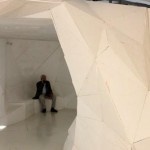
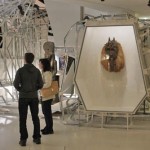
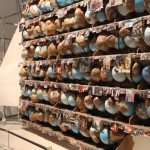
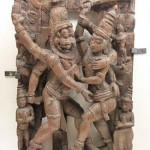
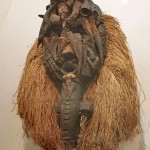
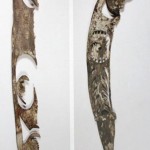
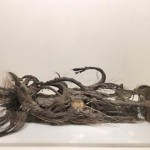
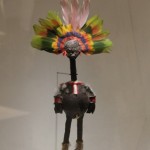
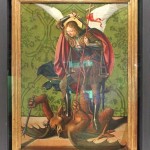
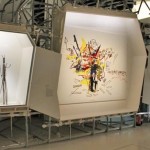
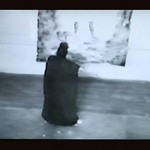
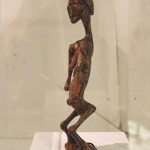
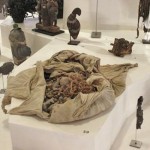
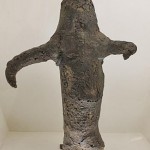
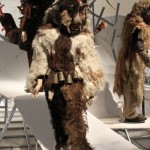
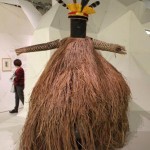

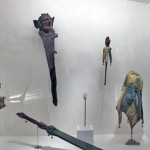
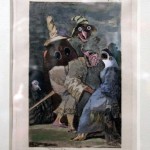
The Paul McCarthy video of the self consumed artist was a wonderful counterpoint to the anonymity of the great primitive pieces.
The Bolidenfa piece from Mali is frighteningly inchoate.
By the way did Goya make his etchings or did he depend on a master etcher to faithfully reproduce his drawings?